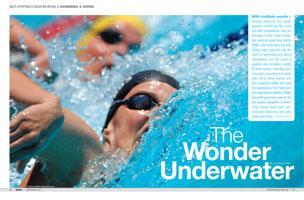
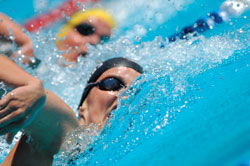 |
| © Chris Schmid - Dreamstime.com |
With multiple events in varying distances and types, aquatics events are like track and field competitions, only underwater. In the United States, two national governing bodies (NGB), USA Swimming and USA Diving, reign supreme over the world of swimming and diving competition, but the world of aquatics also includes a variety of other events, including synchronized swimming and water polo. All of these events, and their respective NGBs, fall under the leadership of the Fédération Internationale de Natation (FINA), the world governing body for the five aquatic disciplines of swimming, diving, water polo, synchronized swimming and open water swimming.
While USA Swimming and USA Diving sanction competition in their specific aquatics events in the United States, a number of affiliated sports event organizations, such as the Amateur Athletic Union (AAU), the YMCA, and the NCAA, plan and execute swimming and diving events for athletes of all ages. A closer look at the events and inner workings of a few of these organizations gives a window into the ways of planning world-class swimming and diving events.
The NGBs
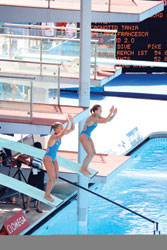 |
| © Fanuweb - Dreamstime.com |
Headquartered in Indianapolis, Ind., USA Diving offers programs for diving enthusiasts from novice to the world champion. USA Diving conducts approximately 40 regional and national events annually and is responsible for training and selecting teams that represent the United States at international events such as the Olympic Games, World Championships and World Cup.
USA Swimming is a 300,000-member organization that promotes the culture of swimming by creating participation and advancement opportunities through clubs, events and education. USA Swimming members range from the age group level to the Olympic Team, participating through more than 2,800 clubs nationwide.
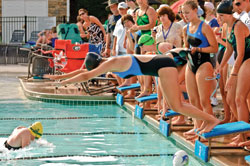 |
| Team members ready to dive in for their lap during a swim meet relay competition in Cumming, Georgia (the Lake Forest Lightning vs. the Long Lake Marlins). © Susan Leggett - Dreamstime.com |
USA Swimming local clubs plan and host many of the 4,000 events that USA Swimming sanctions each year. USA Swimming also hosts a variety of premier annual events, which offer America's Swim Team the spotlight and give fans and younger athletes the chance to see their swimming heroes in action. And fans and athletes alike take advantage of that opportunity, making spectators an important consideration when planning a USA Swimming national event.
"For our national events, finding the right facility is relatively simple because there are so few facilities large enough for our events in the first place," says Dean Ekeren, events and marketing director, USA Swimming. "Only about six or eight facilities can accommodate our national championships, so we try to rotate among them."
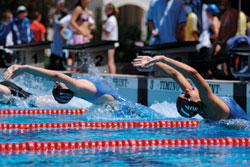 |
| Competitors at the start of the backstroke competition. © Peter Muzslay - Dreamstime.com |
In August 2011, Stanford University's Avery Aquatic Center, widely considered America's finest outdoor swimming and diving facility, will host both the Conoco Phillips National Championships and the Speedo Junior National Championships. Featuring four separate pools-the Avery Competition Pool, the Maas Diving Center, the Belardi Pool and the Baker Pool-Avery Aquatic Center is said to offer possibly the fastest water in the nation.
When looking for a facility to host its Olympic trials, however, USA Swimming has simply outgrown all the possibilities, which is when the organization decided to take matters into its own hands, along with the hands of some pool-building professionals.
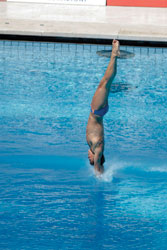 |
| 10M Platform Diving at the FINA World Championship. © Armando Iozzi - Dreamstime.com |
"Since there's really no venue that can accommodate the trials, we simply rent a convention center and install two temporary 50 meter pools," says Ekeren. "Myrtha Pools is a corporate sponsor of USA Swimming, and we use their pools, which are built in a modular fashion. They're designed to be used as a high quality permanent installation, of course, but the modular design also makes it possible for us to take the pools out when we leave."
The Olympic trials are a great example of how, after more than 30 years of leading the American swimming community, USA Swimming continues to increase its membership and its sport's popularity.
"Our leadership has always been outstanding, but we're also basically a volunteer-run organization," says Ekeren. "Certainly the excellent performance of our Olympic team has allowed our sport to grow, and the popularity of some of our top swimmers right now has really encouraged a lot of kids to get in and stay in the sport."
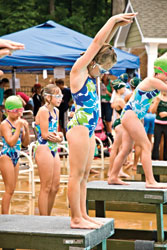 |
| A group of young girls on the platforms ready to enter the water for their competition (Atlanta Swim Association, Lake Astoria Crocks team vs Lake Forest Team). © Susan Leggett - Dreamstime.com |
The Olympic trials are owned by the United States Olympic Committee (USOC), so USA Swimming does not sell sponsorships for that event. However, USA Swimming does have the support of several corporate sponsors, which have privileges at all the organization's regional championships.
"We're just seeing the sport's popularity increase tremendously, which in turn helps with our sponsorship sales," says Ekeren.
Omaha's Qwest Center will once again host the United States Olympic Trials in Swimming in 2012, an event that promises to be bigger and better than any the swimming world has seen before.
Mizzou Aquatic Center
Speaking of fast water, Chris Seris, manager of the renowned Mizzou Aquatic Center, explains exactly what that phrase means.
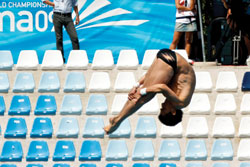 |
| 10M Platform Diving at the FINA World Championship. © Armando Iozzi - Dreamstime.com |
"A lot of it has to do with minimizing wave action, the reverb of waves created by swimmers," says Seris. "Specific things have been done at Mizzou to make that happen. The deeper the water, the further waves go down before the bounce off. Our pool ranges from 8 feet deep on the ends to 8.5 feet in the middle. We also have wide gutters on the sides. They swallow the waves swimmers generate, so the waves don't bounce back and slow swimmers down. Wide lanes are also important. In our 8-lane, 50 meter competitive pool, the lanes are 9 feet wide, which allows swimmers to pass before the waves bounce back. And finally, the lane lines themselves have wave-eater type discs that spin independently and absorb waves."
No matter how a facility achieves it, fast water doesn't happen accidentally. America's fastest aquatic centers all have one thing in common: planning.
"We began planning to build this pool in 1998, and we had a choice: the architect asked, do you want a great competitive facility, or do you want to put the emphasis on creating a facility for leisure and recreational swimmers?" says Diane Dahlmann, director of Mizzou Rec Services and Facilities. "We knew we'd be the home of the Mizzou Tiger swim and dive teams, so it became very clear we needed to put our chips into having the best competitive water so our pool would become a destination location for competition swimming."
Their gamble paid big dividends. The Mizzou Aquatic Center has hosted two Big 12 men's and women's swimming and diving championships to date, and are scheduled for the 2012 meet. After an impressive debut event in 2007, USA Swimming offered the Mizzou Aquatic Center the opportunity to host one of the seven meets in its Grand Prix series through 2016. Now, every February, the Mizzou Aquatic Center hosts the Missouri Grand Prix, a four-day event that attracts many of the country's top swimmers, including Michael Phelps and Natalie Coughlin, as well as international swimming stars.
YMCA
For premiere events, fast water is at the top of the event planner's criteria, but for other event planners, like the YMCA, destination rates just as high as pool technology.
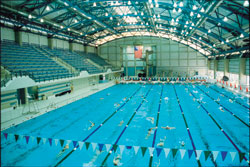 |
| Nassau County Aquatic Center. Photo courtesy of Long Island Convention and Visitors Bureau. |
"For swimming and diving, we look for a destination that would be attractive for our participants," says Noel Brendefur, sports and recreation specialist, YMCA of the USA. "For the national championships, we require a relatively large venue that can accommodate not only the sheer numbers of athletes, but also spectator seating that can accommodate the group as a whole, with parents, siblings and others who come to watch."
One of the key factors in the YMCA of the USA's decision to choose a destination is the having a local YMCA in the area that can partner with the event, offering support, resources and volunteer assistance. Brendefur also points out the importance of choosing a location with a family-friendly atmosphere, as well adequate hotels in a range of price points, to accommodate the group within close proximity to the venue.
The YMCA of the USA hosts five National Championship Meets, serving over 5,000 YMCA athletes attending with their local YMCA teams for the national title in their sport.
"We have nearly 2,700 YMCAs across the country, and we're a mission-driven organization," says Jim Wheaton, national director of events, YMCA of the USA. "The Y is about strengthening communities and nurturing the potential of every child and adult in our organization. Everything we look at is through the lens of creating a healthy spirit, mind and body for all. The ‘for all' part is important, too. We are an inclusive organization. We don't deny access based on ability to pay."
That no-financial-limits part is important as well. The organizers of the YMCA national swimming and diving championships are, like most event owners, always keeping an eye on costs. But at the Y, keeping costs down is critical not because it increases profits, but because every savings are passed on to YMCA athletes and their families. Additional support comes in the form of products and financial contributions from a mix of sponsors. And that is important, especially in aquatic sports, because millions of kids would never even learn to swim if not for this organization: the YMCA is one of the largest providers of swimming lessons in America.
"One of the biggest things about our events," says Wheaton, "is that instead of an event, we try to make it about the total experience."
What does the total experience look like? The YMCA's recent Short Course National Swimming and Diving Championships, which has been held in Ft. Lauderdale for 32 years, is a good example.
"The Ft. Lauderdale Aquatic Complex is a great outdoor venue with multiple pools that can accommodate our athletes," says Brendefur.
More than 200 teams competing in more than 40 events, making the YMCA Short Course Nationals one of the largest youth swimming national championships in the U.S., with more than 1,500 athletes between the ages of 12 and 18.
This is a national championship with many different events, but the Opening Ceremony is the most unique of all of them. A parade of athletes in themed costumes (2010 theme: Hollywood), the Opening Ceremonies, conducted to the "YMCA" song, sets the exact tone of fun and community that the event's planners are going for.
College Aquatics
The East Coast is home to one of college's great swim-and-dive meccas, the Nassau County Aquatic Center. Built in 1998 for the International Goodwill Games, the Nassau County Aquatic Center in Eisenhower Park is the home of a number of aquatics' records.
Host of the annual Eastern Conference Athletic Conference (ECAC) Swimming and Diving Championships, the 80,000-square-foot Center includes a "stretch" 50-meter pool that is 68 meters long, with three movable bulkheads, as well as 50-meter, 25-yard and/or 25-meter lap lanes, depending on the pool setup. The diving well features a 10-meter competition diving tower - the only such tower in the New York metropolitan area - and 1- and 3-meter springboards.
Currently undergoing $17 to 20 million in renovations, look for the updated Nassau County Aquatic Center to make a splash in the world of swimming and diving events in the near future.
The University of Alabama natatorium is another of scholastic swimming's top facilities. "We just finished up the Alabama High School Athletics Association's Swimming and Diving Championships," says Don Staley, executive director, sports, Tuscaloosa Tourism & Sports Commission. An event shared with Auburn University, alternating between the two schools each year, the championships offer an opportunity for the University of Alabama's facility, as well as its department of athletic recreation, to shine.
"George Brown, the director of the department of athletic recreation at UA, did a fantastic job, as usual," says Staley. "We have a great working relationship with the University, and the Student Rec Center and its aquatic facility are such amazing resources. But most important, George Brown has a great staff, and indoor or outdoor, anything they put their hands on, they do an outstanding job."

